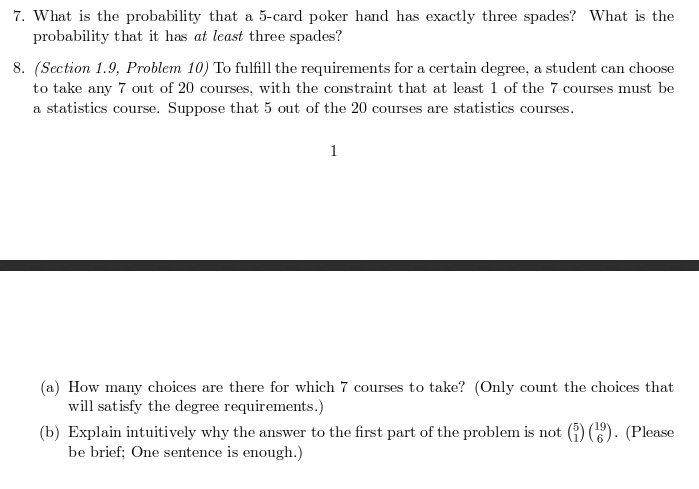Poker Hand Probability Problems
Andymath.com features free videos, notes, and practice problems with answers! Printable pages make math easy. Are you ready to be a mathmagician?
Find the probability of getting the following hands in a game of traditional 5 card poker.
(1)) P(Having exactly 2 Aces) (other 3 cards can be anything but aces)- After finding the number of ways to get four-of-a-kind for four cards in a poker hand, should you use: a. 48 choose 1 or b. 12 choose 1 x 4 choose 1.
- Probability of making a specific hand (7 out of 52) The following chart shows the probability of getting a certain hand. Whereas a pair floats by often enough, getting a straight or royal flush is less likely. 7 out of 52 means, that although you build your hand using 5 cards, you still have 7 cards from which to choose these 5.
Each of the 2,598,960 possible hands of poker is equally likely when dealt 5 cards from a standard poker deck. Because of this, one can use probability by outcomes to compute the probabilities of each classification of poker hand.


See Related Pages()
(bullettext{ Probability with Coin Tosses})
(,text{Prob(3 heads)}=frac{1}{8})
(bullettext{ Probability with Marbles })
(,text{Prob(3 red)}=frac{7}{20}…)
(bullettext{ Probability with Dice})
(,text{Prob(Two 6’s)}=frac{1}{36}…)
(bullettext{ Probability with Round Tables})
(,(n-1)!…)
(bullettext{ Probability with Poker Hands})
(,text{P(Full House)}=…)
Search More Math Topics

(bullettext{ Andymath Homepage})

Poker Hand Probability Problems Solving
Please Subscribe on Youtube
Let nCk denote all the combinations of n objects in groups of k elements. It should be obvious that we need to work with combinations and not permutations as the order of the cards in our hand of cards is irrelevant.

(a) We have to select one suit out of 4 which can be done in 4C1 ways and, once the suit is chosen, we have to select 5 cards from that specific suit and this can be done in 13C5 ways. Finally, in a game of poker there are 52C5 possible hands. Hence, the probability of a flush is given by
(4C1 x 13C5)/ 52C5 = 0.001981 or 0.1981%
For part (b) we follow the same approach, but this is more complicated. In fact, in this case, we must recognize that
i) A pair can be formed in 13C1 ways. Once the card that forms the pair has been selected, we must choose 2 of the 4 cards with that particular number of them, i.e. 4C2.
ii) Then we have to choose other 3 cards from the other denominations, i.e. 12C3 and then for each of these cards we have 4C1 ways to select a card with that number of it.
Hence the probability of one pair is
(13C1 x 4C2 x 12C3 x 4C1 x 4C1 x 4C1)/ 52C5 = 0.4226 or 42.26%
For (c ) we have 13C2 ways to select what denominations will be used to form the 2 pairs, and once the two denominations are chosen, for each, we have 4C2 ways to select the two cards. The remaining card can be chosen from the remaining 11 denominations, i.e. 11C1 and then we have 4C1 ways to select the card from any of those denominations.
Poker Hand Probability Problems Worksheets
Thus the probability of exactly two pairs is
(13C2 x 4C2 x 4C2 x 11C1 x 4C1) / 52C5 = 0.0475 or 4.75%
We should now be sufficiently familiar with the arguments to use for part (d) and I will not provide all the details, but just the answer, i.e.:
(13C1 x 4C3 x 12C2 x 4C1 x 4C1) / 52C5 = 0.0213 or 2.13%
To find the probability of four of a kind, we have to select one denomination to use and then complete it with another card chosen among those the remaining 48 cards, i.e.
(13C1 x 4C4 x 48C1)/ 52C5 = 0.00024 or 0.024%